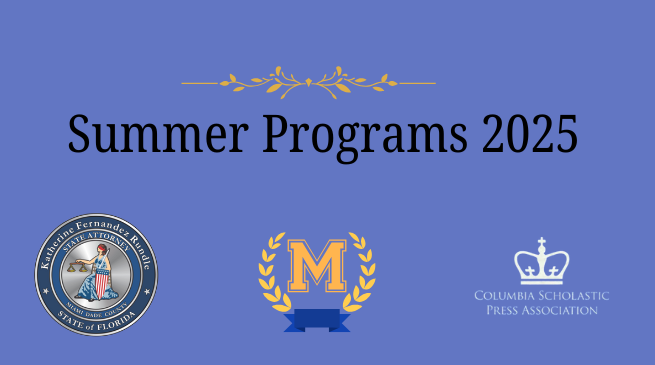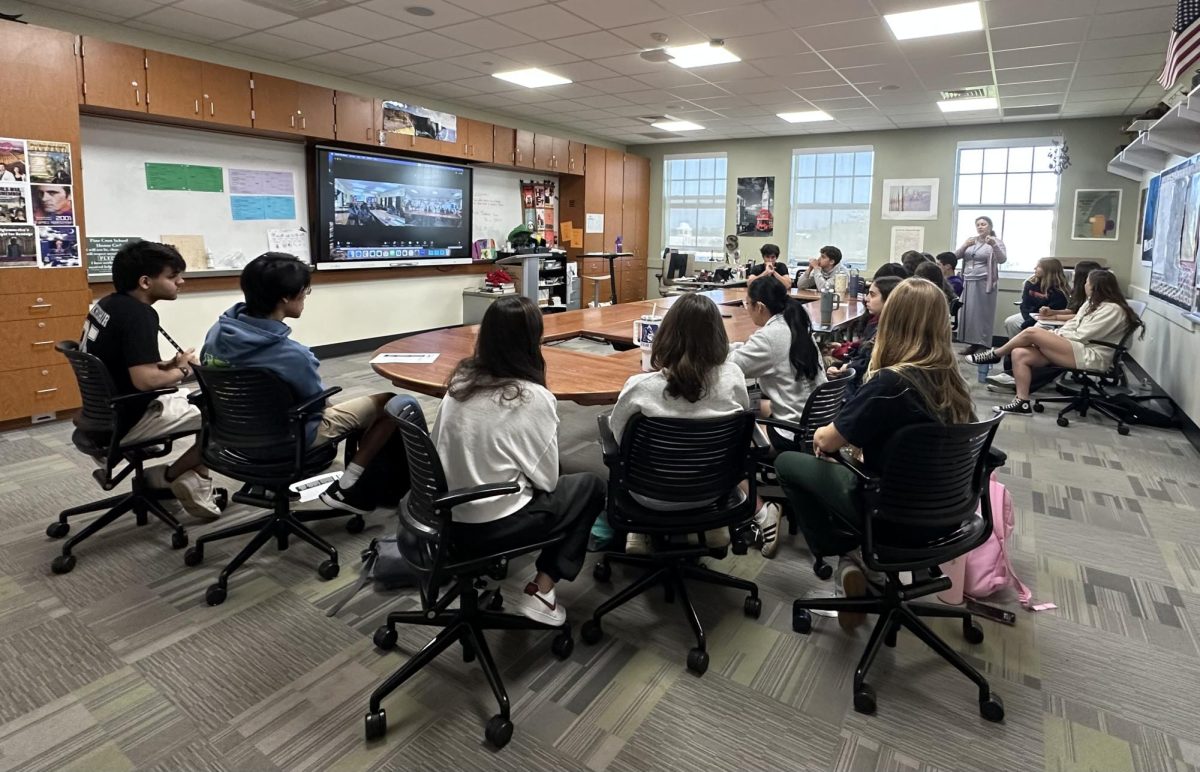[ot-caption title=”Co-editors-in-chief Jodie Kahan and Samantha Meade comment on the phenomenon of fake news.(via Hiba Ismail, senior)”]
We now live in what has been dubbed “The Age of Information.” This is the era when you can learn how to code on Youtube, order Dominos on Twitter, create a blog for free that gains serious traction. However, information overload comes at a price. The Oxford Dictionary named “Post-truth” as their word of the year, an adjective they’ve defined as “Relating to or denoting circumstances in which objective facts are less influential in shaping public opinion than appeals to emotion and personal belief.” So perhaps this age of Information has transformed into an Age of Post-truth, one where “alternative facts” are more influential than real facts. For the industry of journalism, this means that fake news has equal weight and opportunity to thrive in the media.[spacer height=”20px”]
To believe suggests that there is no tangible evidence or that some may argue with reason for an opposite “belief.” And so we not only believe but know that fake news is dangerous to both society and the industry of journalism, and will therefore combat this phenomenon both as citizens paying attention to the media and as editors of our own publication.[spacer height=”20px”]
The face of media has changed immensely since the days of one news channel and a weekly printed newspaper. Today news is everywhere, especially online. But how does this news get filtered to separate what is fact and what is fiction? The short answer: it doesn’t. The optimistic and naive part of us wants to believe that fake news headlines are an accident and a result of overzealous journalists eager to release a story. However, the reality is that much of fake news is released intentionally for monetary reasons.[spacer height=”20px”]
The primary cause for the spread of fake news is social media. This information overload means that we’re seeing stories that may not just be inaccurate, but totally made up. And if a fake news story gains traction online, another more legitimate source may pick it up without ever tracing it back to the original and untrustworthy source. Creating content in today’s media landscape is remarkably easy, and creators have grown rather smart in a way that hurts us all. Allen Montgomery (which is not his real name) is the founder of The National Report, an online newspaper that boasts its legitimacy with its tagline, “America’s #1 News Source.” In an interview with the BBC he said, “Obviously the headline is key, and the domain name itself is very much a part of the formula – you need to have a fake news site that looks legitimate as can be.” To him, journalism is a game, one where clicks and shares give him points. “Beyond the headline and the first couple of paragraphs people totally stop reading, so as long as the first two or three paragraphs sound like legitimate news then you can do whatever you want at the end of the story and make it ridiculous.”[spacer height=”20px”]
Although fake news sounds like something that’s simple to avoid, it’s actually more complex. Much of the reason people are enticed to believe certain stories is because it proves their opinion or worldview right. This is a phenomenon known as confirmation bias. News sites like The National Report know that if they post an article that confirms speculatory accusations, millions of people will share the article with a caption reading something along the lines of “I told you so.” In fact, they bank on this phenomenon for all of their revenue.[spacer height=”20px”]
The phrase “You can’t make this stuff up!” has been turned inside out now that sites that could have once appeared to be legitimate have started to actually just make “stuff” up. As more news franchises turn toward the web as their major platform (shoutout Type One), they are starting to manipulate headlines, gearing toward what will get the most clicks. Even if a false story originated from a true fact, the article can become overly dramatized until it loses its original intent.[spacer height=”20px”]
Of course, it is expected that these publications need to make money at the end of the day. However, owners and investors in charge are losing sight of the difference between vital news that is a journalist’s duty to spread and fluff pieces. In a Last Week Tonight with John Oliver episode, Oliver focuses on the journalism industry. Around eight minutes into the video, Oliver discusses online newspapers that are posting irrelevant stories to make greater revenue, like billionaire Sam Zell, owner of the Tribune Company (manages major publications such as Orlando Sentinel, Chicago Tribune, and LA Times).[spacer height=”20px”]
While there is a difference between fluff stories and fake news, they both stem from the same motives: to boost revenue.[spacer height=”20px”]
It is true that words and meanings change in an evolving society. However, it is our opinion that news should remain news, which is to say news is based upon factual evidence. As a student newspaper run by future journalists and content creators, there are a series of measures Type One takes in order to preserve journalistic integrity. First, all of our citations are taken from credible sources that are thoroughly checked by several people in the editing process. Next, all quotes are taken directly from the source credited, and no quote is taken out of context to manipulate someone’s original intent. Our mission as a student newspaper is to educate and inform the Pine Crest community, a job we take with pride and a responsibility to our readership.[spacer height=”20px”]
Incidents in any demographic or industry can cause people to lose sight of the bigger picture. Generally, journalists strive to share fair and complete news that its audience not only needs to know, but also deserves to hear. However, other motives can cause reporters to forget that the media is simply a group of people set out to inform other people. Emotions and opinions do flow in and out of this industry, and it is important that journalists remain grounded to their ethical values.[spacer height=”20px”]
Society of Professional Journalists (SPJ) has a Code of Ethics that promotes integrity and thoroughness in an industry that is oftentimes seen as faceless and heartless. “Be Accountable and Transparent” is one of the headlines in the SPJ Code, a section that focuses on clarity and candor when articles spread fake news.[spacer height=”20px”]
By allowing ourselves to take part in the cycle of fake news, we are spreading gossip as if we were back on the playground. An educated audience is just as powerful as an educated reporter; one needs to know when to stop the cycle. Whether we are creating, reading, sharing, or retweeting news, it is important as the next generation to enter college and ultimately the workforce to understand legitimate sources and stories and weed out false ones.[spacer height=”20px”]
As a publication that creates news by students for students, we, Type One, abide by the industry’s expectations for young journalists, and are honored to be tasked with providing news to the Pine Crest community. We acknowledge that it is our duty to provide accurate and clear coverage of news of all varieties, from all points of view.[spacer height=”20px”]
Sources: BBC, Youtube, The Daily Dot, SPJ
































![Stranger Things 4: What to Expect [Warning: Contains Spoilers]](https://pcpawprint.com/wp-content/uploads/2021/11/StrangerThings4-900x473.jpeg)


























































